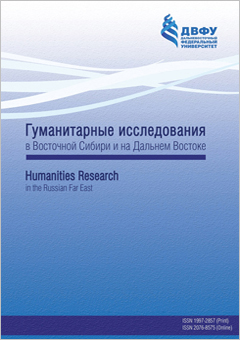Dragons on the official emblems of tsarist Russia
DOI:
https://doi.org/10.24866/1997-2857/2021-4/21-32Keywords:
dragon, serpent, symbol, emblem, sphragistics, numismatics, heraldry, faleristicsAbstract
Dragon is one of the most common symbols in the world. However, its interpretations differ significantly in European and Asian cultures. This raises the question of the semiotic status of such an ambiguous symbol in Russian culture, which occupies a liminal position between the West and the East. The article attempts to trace the emergence of dragons on the official emblems of pre-revolutionary Russia, including princely seals and coins, territorial coats of arms, military insignia, and commemorative badges. The author reveals several independent dragon images, which differ from each other in composition, cultural origin and semantics. It is noted that until the 16th century there was only one type of dragon dominating on Russian emblems that was borrowed from Orthodox iconography and therefore had a consistently negative meaning. The subsequent emergence of new dragon images was a direct result of the extension of Russian territory in the eastern direction and the formation of special Eurasian frontiers – initially in the Volga region, and then in Transbaikalia and the Amur region. The article focuses on the cultural artifacts related to them, depicting local dragons, and identifies their semiotic roots and place on the official emblems of tsarist Russia.
Downloads
References
Арсеньев Ю.В. Геральдика: лекции, читанные в Московском археологическом институте в 1907/8 г. М., 1908.
Арциховский А.В. Древнерусские областные гербы // Ученые записки МГУ. 1946. Вып. 93. История. Кн. 1. С. 43–67.
Валеев Ф.Х., Валеева-Сулейманова Г.Ф. Древнее искусство Татарии. Казань: Татарское книжное издательство, 1987.
Винклер П.П. Гербы городов, губерний, областей и посадов Российской Империи. СПб., 1899.
Высочайше утвержденное положение Сибирского комитета о рисунке герба для Кяхтинского градоначальства (21 декабря 1861) // Полное собрание законов Российской империи. Собрание второе. Т. 36. Ч. 2. СПб., 1863. С. 639.
Высочайше утвержденные, подробные описания государственного герба, государственной печати и гербов Членов Императорского Дома (11 апреля 1857) // Полное собрание законов Российской империи. Собрание второе. Т. 32. Ч. 1. СПб., 1857. С. 297–307.
Высочайше утвержденный доклад Сената – Об утверждении гербов городам Казанского наместничества (18 октября 1781) // Полное собрание законов Российской империи. Собрание первое. Т. 21. СПб., 1830. С. 289–291.
Высочайше утвержденный доклад Сената – О гербах городов Тульского Наместничества (8 марта 1778) // Полное собрание законов Российской империи. Собрание первое. Т. 20. СПб., 1830. С. 598–600.
Герб Кяхты // «Геральдикум». URL: http://www.heraldicum.ru/russia/subjects/towns/kahta.htm
Герб Старого Крыма. // «Геральдикум». URL: http://www.heraldicum.ru/ukraine/towns/starkrym.htm
Иванов Вяч.Вс. Дракон // Мифы народов мира: энциклопедия. Т. 1. М.: Большая Российская энциклопедия, 2000. С. 394–395.
Кобзев А.И., Рифтин Б.Л. Лун // Духовная культура Китая: энциклопедия. Т. 2. М.: Восточная литература, 2007. С. 506–512.
Коваленко А.И. Государственная символика в культуре казачества восточных окраин России // Военно-исторический журнал. 2009. № 4. С. 63–65.
Королев Г.И. Змий или Дракон? // Гербоведъ. 1998. № 2. С. 64–68.
Куренная И.Г. Территориальная символика Восточной Сибири (2-я половина XVII – начало XX вв.). Новосибирск: Наука, 2010.
Курто О.И. Русский мир в Китае: исторический и культурный опыт взаимодействия русских и китайцев. М.: Восточная литература, 2013.
Лакиер А.Б. Русская геральдика. Кн. 1. СПб., 1855.
Медведев М. Нерептильный дракон // Родина. 2005. № 8. С. 57–60.
Нагрудный знак. Памятный знак в честь 50-летия заключения Айгунского договора (1958–1908) с памятником Н.Н. Муравьеву-Амурскому в Хабаровске // Государственный каталог музейного фонда Российской Федерации. URL: https://goskatalog.ru/portal/#/collections?id=13984342
Соболева Н.А. Происхождение печати 1497 года: новые подходы к исследованию // Отечественная история. 2000. № 4. С. 25–43.
Соболева Н.А. Феномен казанского герба: история, семантика, реальность // Очерки феодальной России. 2012. Вып. 15. С. 128–172.
Фоменко И.К., Щербакова Е.И. Западный след «Казанского дракона» // Золотоордынская цивилизация. 2017. № 10. С. 378–389.
Хагондоков К.Н. Уральцы на охране Китайско-восточной железной дороги // Казачий союз. 1952. № 10–11. URL: http://gorynych.gixx.ru/Gorynych/out/Hagondokov-KVGD.htm
Ханфазаров Н.Г. Символы Татарстана (мифы и реальность). Казань: Фикер, 2001.
Худяков М.Г. Очерки по истории Казанского ханства. Казань, 1923.
Янин В.Л. Актовые печати Древней Руси X–XV вв. Т. 2. М.: Наука, 1970.
Fox-Davies, A.C., 1909. A complete guide to heraldry. London: T.C. & E.C. Jack.
Downloads
Published
Issue
Section
License
Copyright (c) 2021 Humanitarian research in the Eastern Siberia and the Far East

This work is licensed under a Creative Commons Attribution-NonCommercial-NoDerivatives 4.0 International License.















